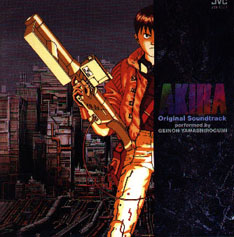

Rating: **** (4 out of 4)
Availability: Widely Available
According to the liner notes, Director Katsuhiro Otomo went to great lengths to procure the music of Geinoh Yamashirogumi for his post-apocalyptic story Akira, and it was well worth it.
In Japan, the experimental musical organization Geinoh Yamashirogumi is synonomous with the future, employing musical techniques and forms that are well ahead of their time. For Akira, Geinoh produced the original score to fit specific scenes and elements in the movie.
The album opens with the explosive theme of the main character, Kaneda. A burst of static fills the air, then slowly moves from speaker to speaker (this is an album the has to be listened to in stereo) as a rattle, not unlike a snake's, comes up from under the white noise, bringing with it the sound of tribal drums and the faintest hints of voices. As the music swells, the voices become more and more prominent, chanting the Japanese words for "Dragon's Claw," "Broken Glass," "Fire," and other visions of chaos, as well as the name "Kaneda," and the nonsense word "Racera," chanted to heighten the tension of the song.
"Kaneda" is only one of the great songs on the soundtrack. "Battle Against Clown" was written to accompany a motorcycle chase, using machine sounds and heavy breathing as rhythmic devices, throwing in snatches of rhythmic themes from "Kaneda," until the full song erupts forth. "Tetsuo" is a rousing, tribal song that acts as the theme for the troubled youth who goes from being a motorcycle thug to being a near-godlike creature. The song is punctuated with a chant that sounds like it came straight out of a temple.
One of the strangest scenes in the movie is accompanied by "Doll's Polyphony," in which small voices beep and grunt in a rising rhythm, with some voices suddenly shifting to a different melody as a deep-voiced chant moves to the forefront and marches toward the listener, obscuring the smaller voices. The result is chilling.
The Akira soundtrack is an example of what can be done with music in a movie, in this age of endless soundtracks featuring Puff Daddy and the innumerable other boring artists with whom directors hope to attract platinum sales. Pop stars and rap artists are all well and good, but it's orchestration that really moves a scene and makes it memorable.
The opinions expressed in the above reviews are those of Glen Williams and may not represent the views of slac.com or any of its members. Compliments, complaints, and comments should be addressed to gandalf@tricon.net
Reproduction or transmission of the reviews in whole or in part without permission is prohibited.